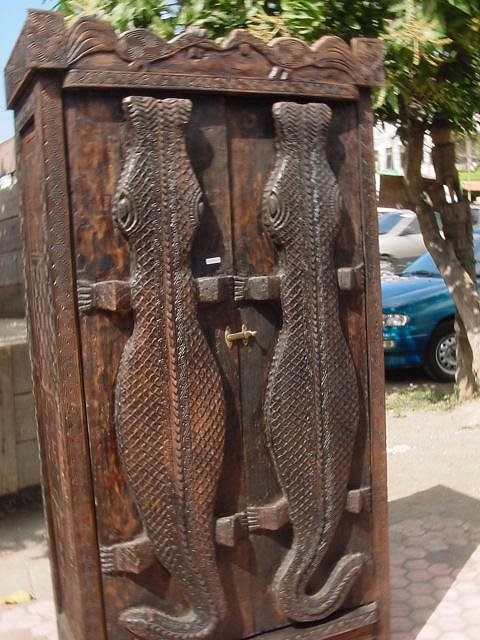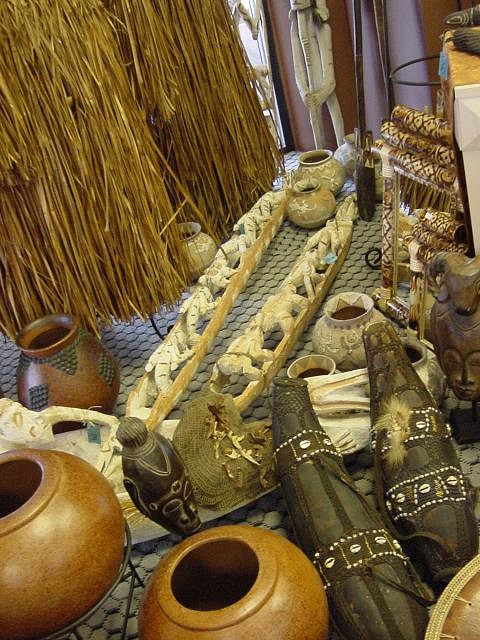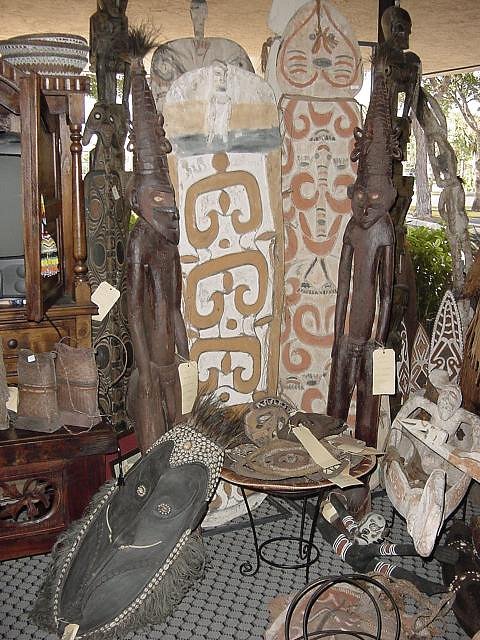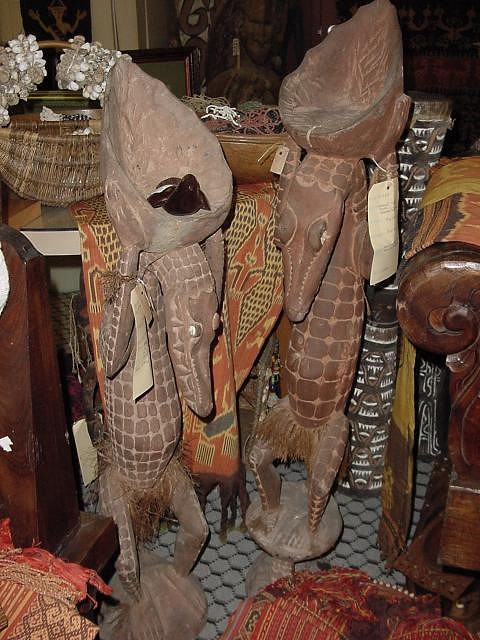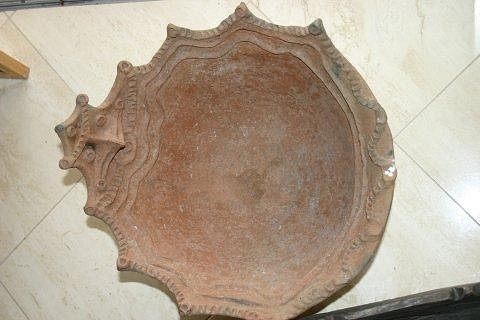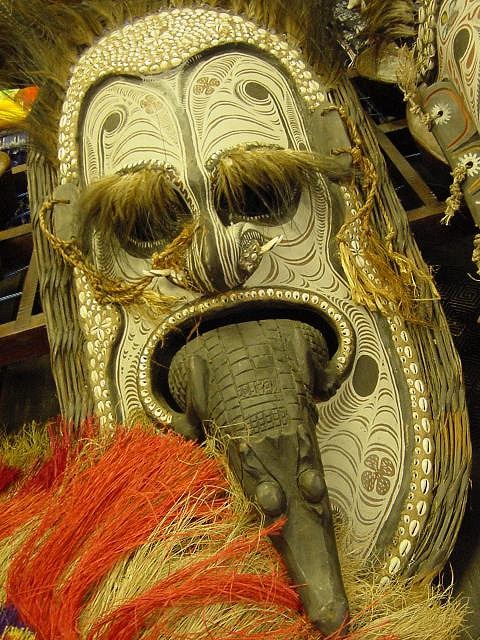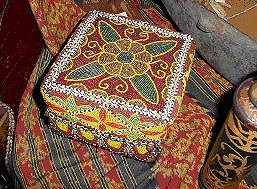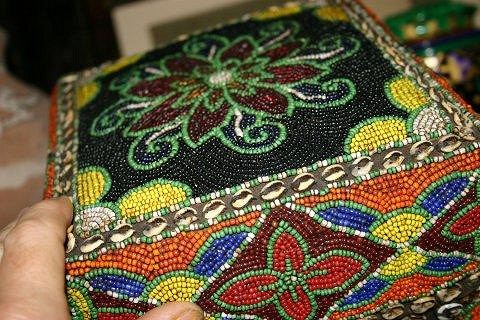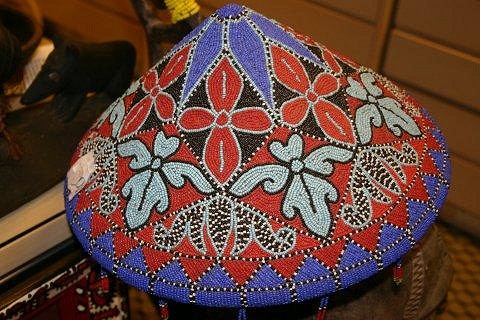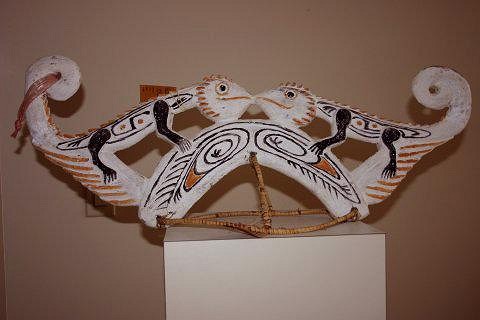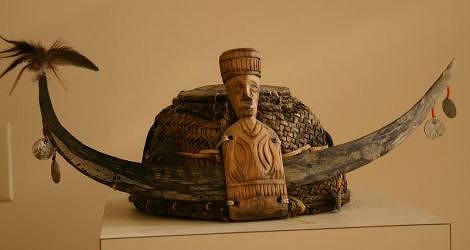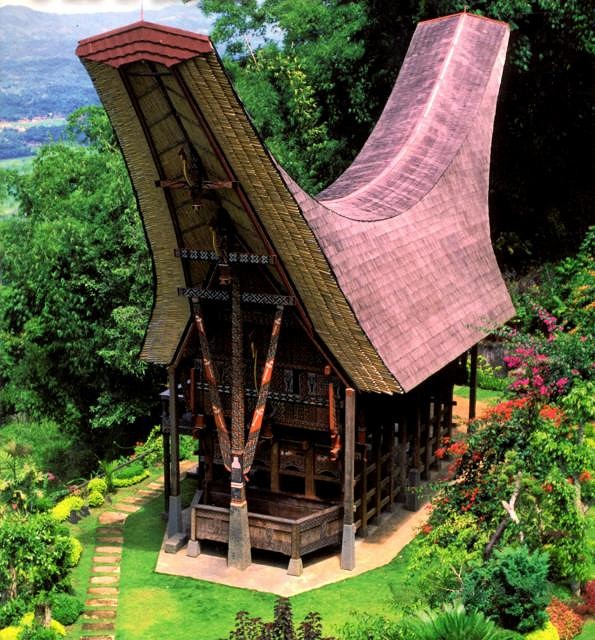Tiki Central / Collecting Tiki
Oceania, Etc: vendor of South Seas Art
|
H
hewey
Posted
posted
on
Tue, Jun 7, 2005 6:03 AM
My computer is freaking out at all the pictures! So am I, but in a different way. Cool pics - thanks heaps |
|
B
Benzart
Posted
posted
on
Tue, Jun 7, 2005 10:19 AM
I'm freaking out with all the cool pictures and Fantastic art. Big thanks to Dreamer and Domi. |
|
T
Tikilicious
Posted
posted
on
Tue, Jun 7, 2005 5:48 PM
So Liz, when are ya gonna take Christie and Chip and Andy and Steve and me? Hmmm? :wink: We are DYING to go with you! Call me! And see you at the party this weekend! Hugs and kisses! |
|
CS
Capt'n Skully
Posted
posted
on
Wed, Jun 8, 2005 3:02 PM
Really cool stuff- Thanks for sharing I Dream Of Tiki! (And Dominique!!) I happened to be driving by today and stopped to look in the windows- Lots of good looking pieces- I was in a hurry, tho, so I didn't call. I'd love to see more. |
|
IDOT

I dream of tiki
Posted
posted
on
Wed, Jun 8, 2005 11:52 PM
Part of a multi-panel door from a house in Timor.
See page 5 for more detail & a full description. [ Edited by: I dream of tiki 2009-02-21 22:53 ] |
|
IDOT

I dream of tiki
Posted
posted
on
Thu, Jun 9, 2005 12:09 AM
Asmat Canoes
"Tribal warfare was officially outlawed by Irian Jaya's Dutch rulers in the 1950s. When the Indonesian government took over the administration in 1962, it began the repression and destruction of traditional Asmat art and culture. This was partly because the artifacts were closely linked to warfare, headhunting, and cannibalism, but it was also an attempt to impose Indonesian rule on the historically unregulated people of Irian Jaya. Due to harsh governmental actions which not only forbade all ceremonies and feasts because of their ties to headhunting, but also outlawed carving and the use of carving tools, these integral aspects of Asmat culture were in danger of dying out. In front of the asmat boats are 2 large rare asmat gourds used for storage." More of the Asmat Collection "Some aspects of Asmat society have been preserved with the support of missionaries such as the Crosiers, who collected and safeguarded thousands of Asmat cultural objects after the 1962 ban and subsequent widespread destruction. The people of the preservation effort encouraged the Asmat people to pursue their traditional culture--without the cycle of killing that was once its focal point. In recent years the Crosiers and others have promoted the sale and trade of Asmat artifacts. Apart from directly benefiting the Asmat, this has created a market for the art which has ultimately engendered a larger awareness of the Asmat people and the changes that have occurred within their culture as they face a future in a world ruled by values far different from their own." "Sepik masks are seen in front portion of photo." [ Edited by: I dream of tiki 2009-02-21 22:58 ] |
|
IDOT

I dream of tiki
Posted
posted
on
Thu, Jun 9, 2005 12:23 AM
Orator's Stool from the Sepik "This is a picture of a large head in the forefront, from the sepik again. It is called an orator's stool. It is a full 5 1/2 foot figure and extremely hard to find and collect, but it is also a stool. The back of the tall figure has a little seat sticking out and part of the trunk it was carved from, except noone sits on it, that is not its purpose: Formal debate is an important and popular practice for many of the Sepik River peoples. The principal accessory of expression during their often violent discussions is a carved represention of an ancestor kneeling or standing beside his personal stool. The disproportionately exaggerated hips, shoulders, and heavy, incised pectorals are characteristic of carvings from this region. The figure carved within the stool or chair probably represents a totemic ancestor. These often larger than life size orator's pieces are the central figures in the Haus Tambaran. No human being sits on these stools, only the invisible protective spirit is there who presides over ritual ceremonies or the settlement of disputes. Typically, an orator stands beside the stool and calls on the clan spirit to support his speech. To emphasis a point, the speaker may strike the "seat" of the stool with a bundle of croton leaves or grass. As long as a man holds the bundle of leaves or grass, he commands the floor. The speaker may gradually reduce the number of leaves in the bundle to show that he is progressing through the points he intends to make." [ Edited by: I dream of tiki 2009-02-21 23:45 ] |
|
IDOT

I dream of tiki
Posted
posted
on
Thu, Jun 9, 2005 12:38 AM
Individual statue stlyings of PNG "The high level of skill of the potters of Lombok, Indonesia, is remarkable. With very simple tools and clay from the local countryside, potters work in their homes to create earthenware pieces of great beauty and utility. Such pieces seen here are a perfect example of how such time honored skills have survived into the modern day. Combining blackened earthenware with rattan and bamboo basketry, artistic ceramics are created with a striking mixture of traditional values and modern appeal. Time consuming hand-etched decorations or shell inserts are added to many of the pieces, each is unique. For over 500 years, the people of Lombok, Indonesia have created earthenware pottery for food preparation, storage and ceremonial purposes. Remarkably, today's artisans still employ the ancient methods of their ancestors, producing pottery, with skills and creativity, that is as beautiful as it is functional." [ Edited by: I dream of tiki on 2005-06-09 08:28 ] |
|
IDOT

I dream of tiki
Posted
posted
on
Thu, Jun 9, 2005 8:38 AM
PNG Crocodile Statues "Chambri pottery is essential for food preparation and storage in the thatched stilt houses along the Sepik River. Although some cooking is done outside, each house has an area where clay is brought in to provide a stable, fire-proof base for a gugumbe or fire dish or fireplace which is about 2-5 ft. in diameter, above. Some Aibom clay Sago pots from the Murik Lake in East Sepik bear the sought after birds head as this one does (a spirit face designed to protect the contents of the pot). Only the Iatmul speaking village of Aibom has suitable clay to make this style of pottery achieved with the coil method. The village sits inland off the middle Sepik River in the Chambri Lakes. Women collect clay from pits at the foot of Aibom Mountain behind the village. In addition to fireplaces, Aibom women make sago storage jars and other smaller pieces. Most women make pots of all types during the wet season. If they marry outside the village they lose their access to the clay pits, but they can still make pots. A potter starts with a double thickness base and adds coils of rolled clay in sausage-shape pieces skillfully placed one above another to build up the form till a finished shape emerges. The coils are smoothed to complete the pot. The pots are dried to the leather-hard stage under the stilt houses, a slow process in the tropics. Although men are also shown making a pot for ritual purposes, making pots is predominantly women's work. The village relies on the trade from these clay pots for much of its subsistence and they are often found in different villages of the Sepik area. Some decorations are often added, sometimes with filets or with finely detailed clay slip designs using natural earth colors of red, black and white. If the women shape the pots, the men traditionally shape the faces and figures on the ridge tiles, sago and ceremonial pots. Men also do the painting. Firing is done before a big market day. The pots are set out in the sun to finish drying, then fired by heaping dried sago palm fronds over the mounded pottery. The firing takes from 30-60 minutes. The pots are properly fired when they turn orange. This produces a very low fire pottery. Chambri pottery is traditionally traded, along with dried fish from the Lakes, for Sepik River sago flour and betel nut, as well as April River grass skirts. The Maringei people, who live close to the small channel into the Lakes, are the middlemen. Traders from Tanbanum village who also trade other pots from other areas, take the pottery as far north as the April River and south to the Murik Lakes near where the Sepik empties out into the sea. Everyone needs a Chambri fireplace and sago storage jars in their house, so there is a ready market."
On the left, a very old and large gathering basket from central Kalimantan, Borneo: Great craftsmanship: The weaving is tight, controlled and consistent. Pattern is simple but decorative. The four upright corner supports are in perfect shape. It has a wonderful patina. Such pieces were used to collect harvest 's goods in the fields and carried on one's back." [ Edited by: I dream of tiki 2009-02-21 22:50 ] |
|
IDOT

I dream of tiki
Posted
posted
on
Thu, Jun 9, 2005 8:45 AM
Another Sepik Mask
"Here is an example of mask sticking a tongue that took the shape of a crocodile from the sepik river." [ Edited by: I dream of tiki 2009-02-21 22:56 ] |
|
IDOT

I dream of tiki
Posted
posted
on
Wed, Sep 28, 2005 8:02 AM
This ol' thread disserves a bump. Dominique also plans to do live painting as well. Please do come check out their table. Also, we have another thread in Beyond Tiki featuring more samples of Domi's own art. [ Edited by: I dream of tiki 2005-09-28 08:06 ] |
|
IDOT

I dream of tiki
Posted
posted
on
Thu, Sep 29, 2005 3:37 PM
Have no idea how I overlooked this photo. Timor Horse! |
|
H
hewey
Posted
posted
on
Sat, Oct 1, 2005 4:45 PM
Awesome pics |
|
IDOT

I dream of tiki
Posted
posted
on
Wed, Nov 16, 2005 7:10 PM
Hooray for the latest installment of indigenous art. As before, I am including research by Dominique in her own words. Lets pick up where we left off with
"These fine and intricately woven traditional wedding baskets that we collected over the last 25 years were created using very time consuming traditional techniques. Each basket is unique, one of a kind and a masterpiece of miniature beading (translucent opaque multi-colored glass; drawn, wound, sewn on), Indonesia, Sumatra, Lampung Bay area, 1930-1960.
"We also found, in Sumatra, 2 coolie hats beaded the same way as the boxes over the same period of 25 years, we never found others, we are assuming they also were used as gifts for Sumatran bride price during a wedding." [ Edited by: I dream of tiki 2009-02-21 00:16 ] |
|
IDOT

I dream of tiki
Posted
posted
on
Wed, Nov 16, 2005 7:26 PM
Just a question for those of you who frequent the thread. Do you want to see some info on the countries these items originate from? Details like geography, cultural facts about the people like agriculture. You know, atlas stuff? My fear is that that information will start to overwhelm the thread with extra details. Its a lot as is on the works alone. Another alternative is to create a separate thread in Beyond Tiki which we can link the geographic info for those interested. Please do tell us what you think. [ Edited by: I dream of tiki 2006-03-29 13:52 ] |
|
F
freddiefreelance
Posted
posted
on
Thu, Nov 17, 2005 2:06 PM
I usually check Wikipedia & the CIA World Fact Book for that Atlas-type stuff, but when the info is intigral to the social fabric that created the art I'd give a qualified "yes." |
|
R
rodeotiki
Posted
posted
on
Thu, Nov 17, 2005 7:43 PM
I have really enjoyed the updates , for me more info would be cool. |
|
IDOT

I dream of tiki
Posted
posted
on
Sat, Nov 19, 2005 5:38 PM
Lets revisit Doors from Timor
"This Timor panel consists of 6 panels and 4 totem columns (155" X 86"), all fitting inside each other like a puzzle. Is is the whole front of a Timor house which looks exactly like a tiki hut, palm roof and all except with a lot of carvings all over." "This is part of a rare handcarved ancestor house front with man and woman effigies collected in Timor (the whole panel could not fit on one picture), made of iron wood, a heavy and very hard wood. It has good luck geckos and other animals carved in the panels as well, a great collector piece: a section of the traditional beehive hut of the Timorese people. The figures represented, ancestor spirits and such are supposed to intercede on the behalf of the villagers and protect them from the demons that lurk around the villages. Nice patina too." [ Edited by: I dream of tiki 2005-11-20 16:58 ] |
|
IDOT

I dream of tiki
Posted
posted
on
Sat, Nov 19, 2005 5:47 PM
Woven Figures, Mamari village, New Guinea |
|
IDOT

I dream of tiki
Posted
posted
on
Sat, Nov 19, 2005 7:32 PM
Back to musical instument. Not just any ol' flute.... KWAKUMBA: RARE FLUTES & FLUTE STOPPERS FROM PAPUA NEW GUINEA The Sepik and Highlands peoples have developed a variety of flutes constructed of lengths of bamboo or cane & coconut shells. They bear elaborately handcarved wooden stoppers depicting human, animal or bird totems additionally adorned with hair, cassowary or casoar feathers, vegetable fibers, shells, seeds and clay-based paints like ochre. They are played during rituals and are considered to be voices of spirits." Kwakumba is the name of the Bamboo flutes found in the Highlands of PNG. Traditionally only initiated men can play them. They are always played in pairs and are pitched slightly apart, the lower pitch - the masculine and the higher pitch - the feminine. Traditionally they play interlocking triplet rhythms that evoke sounds of the bush and village. Airi Ingram was taught Kwakumba by Tony Subam and Pius Wasi from East Sepik Province." Latmul Sacred Flute Players 1999, Middle Sepik, Mumeri Village "The Mumeri people originally came from Kamindimbit Village on the Sepik. During WWII, the elders worried that bombing raids might wipe out their whole village, so some of the people moved up the Korosameri River to its junction with the Blackwater River for safety. The Mumeri men's Haus Tambaran is divided between two clans. They carve clan and ancestor figures and also make beautiful flutes. An item of this size, form and importance, would have been owned by a village or possibly a clan. Flutes often carry motifs or designs which represent clan totems. Flutes consisted of 2 to 3 meters lengths of bamboo, open at one end and sealed at the other with a flute stopper. Typically there was only one hole in the bamboo tube and the production of notes for the haunting music was achieved by men playing flutes with different lengths at the same time. Below is an example of another large scarce flute stopper. On theleft, a bird effigy from the Yamuk village, Latmul group, Middle Sepik River, Papua New Guinea which was used as a stopper on one end of a 10 foot bamboo ceremonial flute. On the right, a complete flute with handcarved and handpainted (with natural pigments) bird and human face stopper mounted on its bamboo tube." Music of Melanesia "Our knowledge of Melanesian music stems primarily from a few early twentieth-century German studies in the Caroline Islands plus isolated German and American efforts before and after World War 2. These materials reveal a predominantly vocal tradition which emphasizes the heightened speech or the litany chant styles. Many of the Melanesian dances are sitting dances - people perform sitting down with much of the movement emanating from the upper body. The island choreography is principally the movement of the arms, which is very different from Africa which is movement of the feet - you rarely see a sitting-down dance there. The ancestral relationship between East Africa and Melanesia is manifested in that much of the music in Papua New Guinea is performed standing, not sitting. When it happens, harmony may be based on any interval, though movement in parallel fourths or the use of a drone are the most common. Most singing is integrated with gesture, whether the music be a lament, an invocation, or a serenade. A great deal of the music is used to accompany dance. Melanesia has the widest diversity of instruments in the region - all types of drums, slit-log gongs, a great variety of flutes and pipes - but no stringed instruments apart from the guitar and ukelele brought in by the Europeans. As you head east into Polynesia, the Melanesian flutes disappear and the instruments become more sparse, but the passion of the music becomes greater - particular the harmonic content which comes straight from the heart. The "gospel choirs" of Tahiti are particularly astonishing. Music is a reflection of topography and people reflect the landscape they are living in. It is must be remembered that these people came to these islands by canoe and only carried what they needed to make the voyage. When they arrived at their destination, there often were no wood or material to make instruments. The canoes were considered sacred, so no effort was made to break them up to make a musical instrument. Broadly speaking, the highland people have more instruments because they have more wood and accessto other raw materials. The atoll people have shells and coconut trees to make instruments. The island people have traditionally few instruments because they didn't carry them in their canoes." |
|
IDOT

I dream of tiki
Posted
posted
on
Sun, Nov 20, 2005 5:41 PM
Scottiki and his lovely wahine Jen came to Oceania this past weekend and were in love with the Timor furniture. These are for you to think about for the future. :) Domi just sent me some photos of Timor peices that she's already sold, but are still very stunning to look at. Hope it will inspire the carving community as well. Timor armoire |
|
IDOT

I dream of tiki
Posted
posted
on
Fri, Dec 2, 2005 5:56 PM
We all know of the Polynesian tapa and have a pretty good idea of how its made. Well, there is also specific tapa design styles from New Guinea. For the mean time, enjoy the pics. "Tapa cloth has been and continues to be used in many ways in the Pacific. It can take the form of a blanket, a room of a ceremonial mask, or loose clothing. It is tradition in the Islands for people to exchange textiles during special ceremonies. The work each piece represents and the good "mana" of the woman who created it testify to the significance of the gift and provide the recipient with good luck. Today it is still customary at weddings for the bride and groom to be given large quantities of finely woven mats and tapa cloth, which are often worn around their bodies in layers as a sign of community blessing. Other passages of life that often involve the ceremonial exchange of textiles are births and funerals. Barkcloth dance capes and laplaps worn by, Papua New Guinea, below." "Nearly 3,000 Maisin live in nine villages spread along Collingwood Bay, their ancestral lands in the north eastern part of the island of New Guinea. Maisin villages retain a traditional culture and subsistence economy. The villages lie far from roads. Villagers continue to garden, fish, hunt and gather wild foods and materials using the techniques of their ancestors. The vast majority rely on outrigger canoes and houses constructed out of materials from the rainforest. Maisin take pride in their customs, such as the initiation for first born children, marriage exchanges, the elaborate facial tattooing of adolescent girls, and the making of beautiful tapa paintings. Although each culture has their own distinctive visual style, tapa manufacture is fairly consistent throughout Polynesia. The inner bark of the Paper Mulberry tree is stripped, soaked and beaten with a wooden mallet on a flat topped wooden anvil (a tutua) to produce sheets of raw tapa. These pieces are then joined and decorated in ways specific to each area. Functional uses include clothing room dividers and bedding. Ceremonial use of tapa includes dance costume, mat coverings, as ceremonial carpet, as gifts at funerals and weddings and formal occasions associated with the state or royalty, and as room dividers on important occasions such as funerals. Contemporary use is limited almost entirely to the ceremonial situations and associated costume. Detail of barkcloth sheet (wan) made from mulberry tree bark, probably from the Maisin people of Collingwood Bay, Oro Province, Papua New Guinea. The open linear diagonal designs are accentuated with dots (sufifi). Their young women's traditional facial tattoos use similar patterning, right." Barkcloth (tapa) from Oro Province, Papua New Guinea (Further information) Barkcloth was widespread throughout Polynesia and parts of Oceania at contact. It was used for clothing and other everyday items and for ceremony. The generic term tapa probably came from the Hawaiian term kapa. Store cloth has replaced barkcloth for daily use, but it continues to be made for ceremonies. Tapa makers in the Pacific range from select groups of royal Polynesian women, to village women in craft cooperatives, to a single Highland man beating out his hat. Cultivated paper mulberry is the preferred bark, although breadfruit and other forest trees are used if they have suitable thick, fibrous inner barks. Strips of bark are soaked, scraped and beaten out on logs or special tables/anvils with tapa beaters. The beaters are made of stone or heavy wood and are sometimes beautifully carved and patinaed from use. Damp, glutinous pieces of bark are over-lapped and beaten together to form large sheets. Sheets are folded and beaten out, refolded and beaten out yet again and again to make a uniform cloth without holes. Early explorers wrote that villages resounded with groups of chanting women beating barkcloth. Tapa can be made as thin and fine as lace or layered into lengths with the consistency of thick felt. Plain tapa, sometimes bleached to pure whites, was often important in traditional Pacific island ceremonies, but it was seldom collected by outsiders. Pattern books of tapa made in the colonial period were very popular. Pattern, whether traditional or contemporary, adds meaning to barkcloth beyond decoration. Alfred Gell writes in Wrapping in Images: Tattooing in Polynesia, Oxford University Press, 1993, that both barkcloth and tattoo designs are seen as an additional layer of skin wrapped around the individual. Tapa patterns are created by staining, painting, stamping and stenciling. In New Guinea, the designs are hand painted. Traditional colors come from local clays, native plant dyes and charcoal." Tapa Cloth and the Rain Forest The Maisin face two types of pressures. The first is economic. The village population is growing but there are fewer and fewer paying jobs available. As money becomes scarce, the Maisin are looking for other opportunities. Their villages are too far from markets for cash-cropping to be viable. Instead, they are hoping to increase the market for tapa cloth. Made from the pounded inner bark of the paper mulberry tree, tapa cloth is a traditional item of clothing and wealth made across the Pacific. Maisin women make the finest tapa in Papua New Guinea. This exhibition at Berkeley's University Art Museum and Pacific Film Archive provides the Maisin with an opportunity to introduce this art form to a North American audience. The Maisin and other rural Papua New Guineans are also under increasing pressure from foreign logging companies and their allies in the national government. The Parliament is currently considering legislation that would make it easier for the government to permit logging over the objections of local landowners. Having largely destroyed the rain forests of southeast Asia, loggers are now slashing the forests of Papua New Guinea and threatening the future of the communities who depend on these resources at a frantic pace. The Maisin are attempting to forge a different path which can be an example for Papua New Guineans and westerners alike. They bring the message that the future of their rain forest--and the rights of the indigenous peoples who live in them--should concern every one of us." [ Edited by: I dream of tiki 2005-12-02 20:04 ] |
|
IDOT

I dream of tiki
Posted
posted
on
Fri, Dec 2, 2005 5:58 PM
CHIEF’S HATS Asmat chief from Irian Jaya Toranja Chief's Hat, Tana Toranja, Sulawesi,Indonesia To this day, the Toraja traditionally live in small settlements perched on hilltops & surrounded by stone walls. Each village is composed of several extended families which inhabit a series of houses called Tongkonan, arranged in a circular row around an open field. In the middle stands a sacred stone or Banyan tree used for ritual offerings, and granaries (lumbung) face the dwellings. This chief’s hat is an extremely rare find. It can only be worn by the chief of the village or the sacred martial dancers who perform the ritual dances. It will make a fine decoration item as well as a fascinating conversation piece for the amateur or collector of rare prized artifacts."
"Toraja warriors wearing the songkok. This helmet has iron projections in the shape of buffalo horns meant to deflect blows." [ Edited by: I dream of tiki 2009-02-21 00:07 ] |
|
IDOT

I dream of tiki
Posted
posted
on
Wed, Mar 29, 2006 2:02 PM
bump :) |
|
IDOT

I dream of tiki
Posted
posted
on
Sat, Jul 8, 2006 12:55 AM
Aloha to everyone! A lousy, lousy thing has happened to my dear friends Dominique and Gary Rice, the proprietors of Oceania, Etc. in Delray Beach, FL. The landlord has informed them that the rent on their store front is going to double in the very near future. This news has resulted in the decision to move out of the store's location, which means the gallery for Oceania, Etc as well as her daughter's store next door. Alas, rent prices are skyrocketing all over South Florida, for both residential as well as commercial. Thus, there are no current plans to open a new store front. What will occur is they and their daughter Tracy need to liquidate as much of the lesser items quickly before the move that must happen before December 2006. They will very likely end up selling the delicate ethnic pieces out of their home, making it truly by appointment. If anyone is interested in some tropical and unique items to decorate your home, a portion is being sold online. Gary and Domi WILL be selling at Hukilau 2006. Please do email Domi at if you are especially looking for something special so they can make arrangements beforehand. Thank you for your interest and support. |
|
IDOT

I dream of tiki
Posted
posted
on
Mon, Mar 3, 2008 7:57 PM
Completely off topic. Amazing to see that shutterfly has not dumped the pics yet, yet the newer site has lost all the shots from page 4. Hmm.. and so begins reconstruction of the page. |
|
V
VampiressRN
Posted
posted
on
Tue, Mar 4, 2008 5:23 AM
YEAH...glad you will restore the pics...the art work is amazing. :) |
|
H
hiltiki
Posted
posted
on
Mon, Mar 2, 2009 1:50 PM
I was looking for some tapa cloth fabric designs and I came up this thread. If you haven't seen it you should check out the entire thread. |
|
H

Hakalugi
Posted
posted
on
Tue, Aug 1, 2017 4:09 PM
These Tongkonan houses are quite amazing.
|
|
UT
uncle trav
Posted
posted
on
Tue, Aug 1, 2017 4:22 PM
Now that would be an interesting build! |


